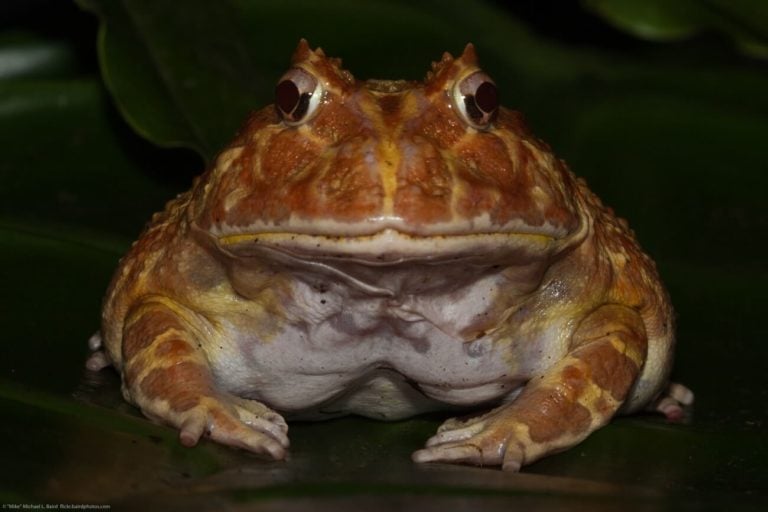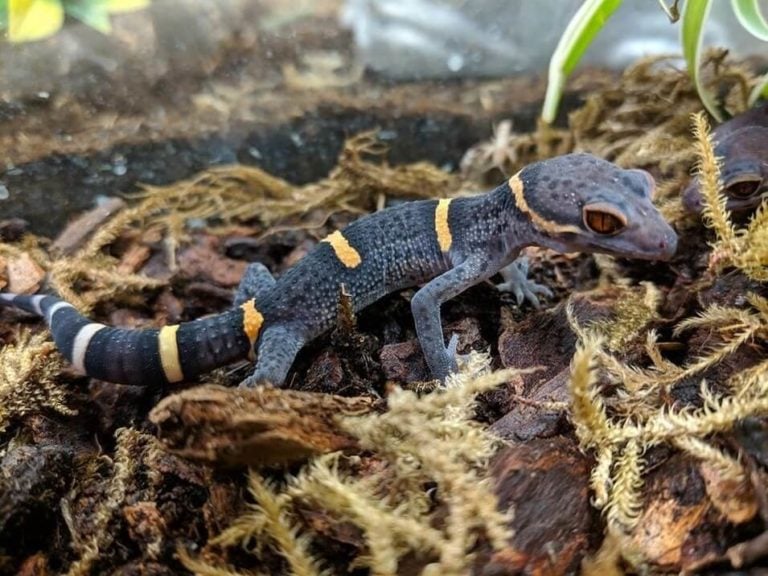Pink-tongued skinks are lovely pet reptiles that we think are very underrated. They’re easy to care for, fun to observe, and have a gentle temperament.
In fact, we frequently hear from owners who are extremely happy they made the decision to get one. More than almost any other lizard!
In this guide you’ll learn about proper pink-tongue skink care, so you can be ready whenever you decide to get one.
Table of Contents
Species Summary
The pink-tongued skink (Cyclodomorphus gerrardii), also called the pink-tongued lizard, is native to forests and woodlands in Australia.
This is an easy going lizard that likes to both climb trees and burrow in leaf litter and undergrowth. Due to its nice disposition and pretty simple maintenance, we highly recommend this skink for novice reptile owners.
Expert Tip: Many people don’t know much about this lizard, because the blue tongue skink hogs all the attention. However, this species is definitely a great pet to consider.
Appearance & Colors
The pink-tongued skink is known for its long, prehensile tail, its long, slender body, wide head, sharp claws and pink tongue (of course).
The body of this skink ranges from a silvery gray to a light-brown color. Dark-brown or black stripes running down the dorsum give this beautiful skink its distinctive look.
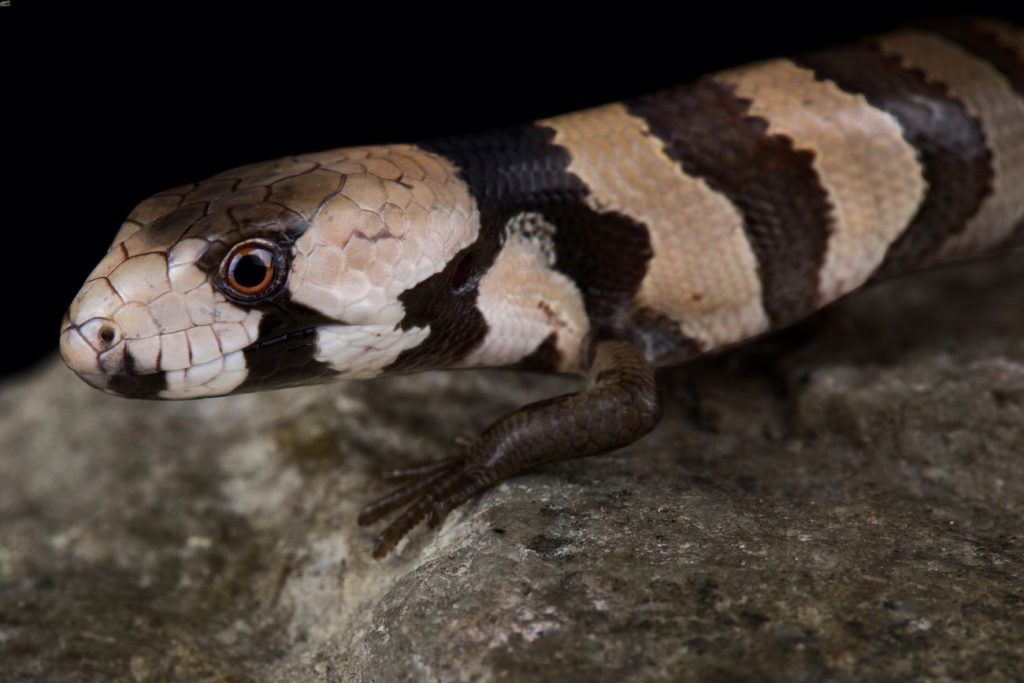
Their legs are rather thin and undefined compared to the rest of their body. Sometimes you might even wonder how they can carry their body weight!
One thing that many owners like about the pink-tongue skink is that they have very expressive eyes for a reptile. Sometimes they can look wide and cute, and other times they look rather serious (especially due to the angle of their head).
Lifespan
Given the right environment and care, the typical pink-tongued skink lifespan is between 15 to 20 years. If you are looking for a reptile that you’ll be able to have for the long-run, the pink-tongued skink is a great choice.
Expert Tip: This number can be influenced significantly by the quality of care you provide. While these lizards are very beginner-friendly, they’re not invincible!
Average Size
The average size of a pink-tongued skink is about 17 inches in length when fully-grown. Most of this length actually comes from its long, prehensile tail.
In reality, seeing these reptiles in person really makes it clear how small they really are. Its diminutive size makes the pink-tongued skink the perfect match for owners who don’t have the space for a large enclosure and habitat setup.
Pink-Tongued Skink Care
Pink-tongued skink care is fairly easy, making this a great pet lizard for beginner reptile owners.
Its disposition is pleasant, and the lighting, temperature, dietary and humidity requirements are not overly complicated.
Before you buy a pink-tongue skink (or any other reptile) you need to really consider if you are up to the task of caring for them in the long-run. This skink can live for up to 20 years, and its living space will need to be kept perfectly clean in addition to the consistent monitoring of the habitat that needs to be done.
If you feel that you can handle the care and are fine with this level of commitment, then you will have a wonderful pet for many years!
Enclosure Size
For the pink-tongued skink, the size of the enclosure is pretty important. When you’re designing your enclosure, make sure that it has plenty of height. These skinks like to climb, so also need room for branches and other climbing materials.
We suggest an enclosure that is at least 24 by 18 by 18 inches. If you have the room and the means, then a bigger enclosure is even better. Really, you can create any size of enclosure you’d like as long as it meets the recommended minimum size.
Lastly, make sure that the enclosure you choose has a very tight fitting top. Skinks will try to escape, and they are very tempting to cats and small children.
Expert Tip: No matter how big the enclosure is, it’s not a good idea to house more than one male in the same enclosure. They are very territorial and will fight (more on that a bit later).
Two females or a male and two females can be placed together, but they will each need their own areas within the enclosure.
Setting Up The Habitat
There is no steadfast rule about what to put in your pink-tongued skink’s enclosure. You just need to think about their natural habitat and try to reproduce it as best as you can.
Here are our recommendations:
In the wild, these skinks live in forests with lots of leaf litter and places to hide. With this in mind, you will need to add a good substrate, places to climb and reptile hides.
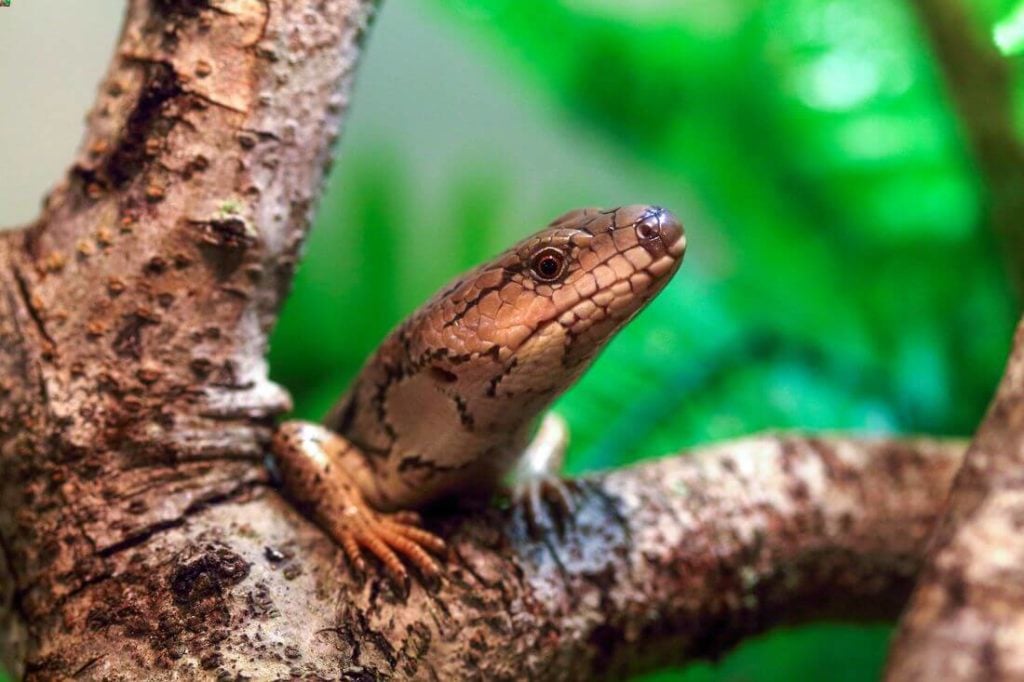
For a substrate, using something like cypress mulch is a good idea. Give your pink-tongued skink a nice, thick layer of substrate, so they have plenty of burrowing material.
Other nice enhancements include branches, pieces of driftwood, reptile hides and artificial plants. Always feel free to change up the enhancements. This will keep your skink interested.
Expert Tip: Don’t make too many changes too often though! There needs to be an element of consistency for these reptiles to feel at home and comfortable. Constantly switching things around will likely cause your pink-tongue skink to feel nervous and stressed.
Temperature & Lighting
One of the reasons that the pink-tongued skink is good for beginners is that the enclosure’s lighting and temperature set-up is fairly uncomplicated.
You’re going to need to create a temperature gradient by making one end of the enclosure the warm end, and leaving the other side as the cool-down side. While this may sound complicated, it’s actually quite simple.
The warm end of the enclosure is where your pink-tongue skink is going to bask. Place some branches and logs on this end and set up your basking lamp. This warm area should remain at 80 degrees Fahrenheit at all times.
The other side of the tank (the cooler side) should remain at 75 degrees Fahrenheit. At night, the temperatures can drop to the low 70’s. If the temperature drops any lower than this you’ll need to rely on a heat source at night.
Pink-tongued skinks don’t necessarily need extra UVB lighting, but we feel that it’s a good idea. All you really need is a single bulb, so adding this supplemental lighting is totally no big deal.
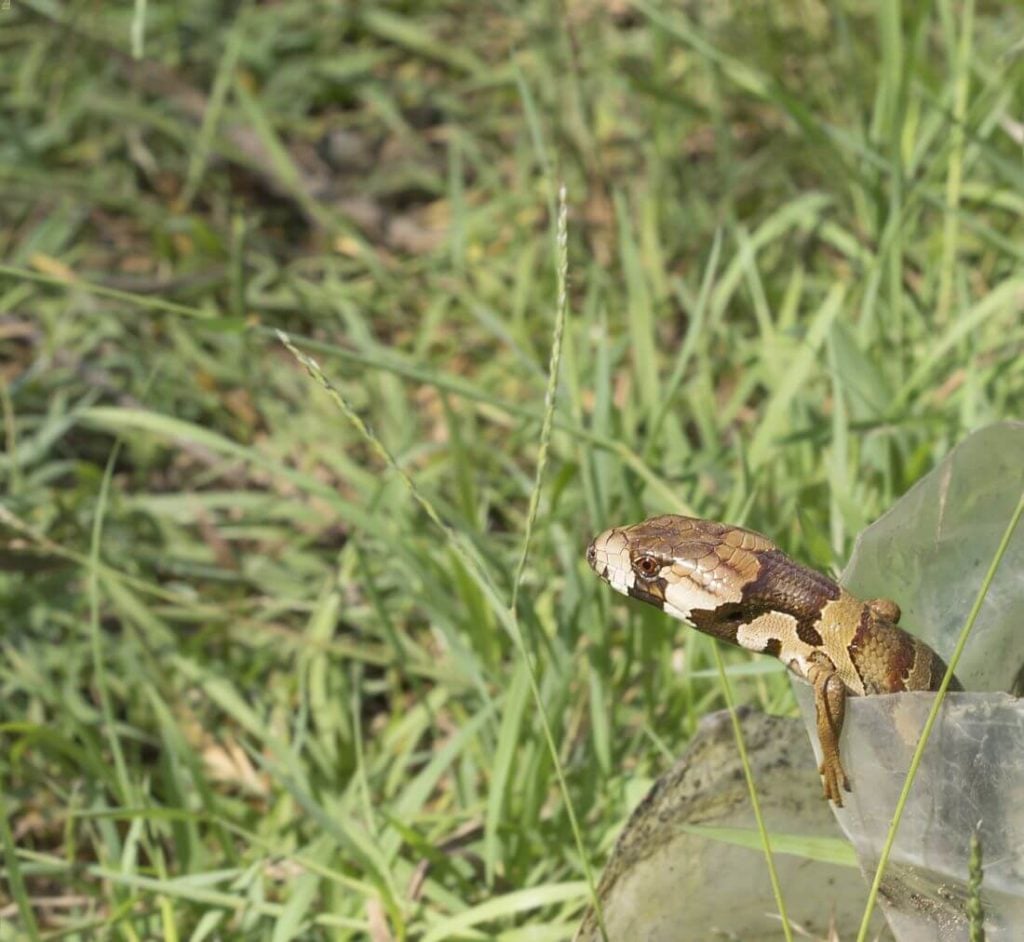
There are lamps available that provide both heat and UVB light, but you can get away with separate sources if you wish. Depending on the size of the enclosure one option might be more convenient than the other.
Humidity
Pink-tongued skinks need an enclosure humidity of 70 to 80 percent. Maintaining this is extremely important for the overall health and comfort of your pet, so it’s something you should be taking very seriously.
Misting the enclosure, having a good water source (more on that below), and using the right substrate will help maintain this high level of humidity. Hand misting the enclosure and your skink several times a day is going to be a habit you’ll need to get into. You can also adjust the ventilation in the enclosure to impact the humidity as well.
Expert Tip: You should invest in a reliable and high quality hygrometer to keep an eye on these humidity levels. Poorly made ones can lead to inaccurate readings, causing you to make necessary changes.
Water
Providing a source of fresh clean water is very important. Keeping a bowl of water in the enclosure not only helps to maintain the right humidity level, but it also helps your pink-tongued skink when it’s time to shed. Also, skinks really like to drink!
Be advised that you’re going to have to change out the water quite often. If you see that it’s dirty, change it right away. You should also give the water bowl a good scrubbing at least once a week.
Failing to keep their water source clean can result in bacterial buildup and other nasty health complications for your pet. Be consistent!
Pink-Tongued Skink Food & Diet
A nice thing about pink-tongued skinks is that they are not super fussy when it comes to diet.
They will eat a nice variety of foods like canned snails, mealworms, wax worms, earthworms, crickets and canned cat food. You can also give them fruit such as bananas, blueberries, mangoes or raspberries.
Feed young pink-tongue skinks every other day or so. Adults, on the other hand, can be fed about three times a week.
Put their food in a shallow food dish, and remove it when they are done. Since every skink is different, it’s hard to say how much to feed them per session. Trial and error works best, and never give them more than they will eat at one go.
Possible Health Issues
Pink-tongued skinks tend to have good general health and be relatively hardy, but you’ll still need to watch out for potential health issues.
The health problems that seem to plague these skinks are similar to ones that affect many other pet reptiles. Observe your pink-tongued skink everyday to see if you notice lethargy, extra mucus, skin issues or a lack of appetite. These are all signs of health distress in your skink, and you will need to address all issues right away.
Some of the common issues you may encounter as a pink-tongue skink owner include obesity, scale rot, respiratory infections, parasites, mites and shedding problems. If caught in time, all of these issues are treatable.
Expert Tip: We suggest finding a veterinarian who is knowledgeable about exotics. This specialized experience will be crucial if your pet ever suffers from a serious illness.
Behavior & Temperament
The pink-tongued skink is known to be rather sweet pets. They usually won’t bite unless they’re provoked in some way, and can be trained to be held for short periods of time.
This skink is both diurnal and nocturnal and can be seen climbing, burrowing and exploring at all times of the day. This decent activity level means they’re a lot of fun to observe!
Handling Them
Even though it’s always best not to handle any pet reptile too often, the pink-tongued skink tends to tolerate handling more than many others. That’s one of the many reasons why this species is such a great pet!
Gentleness and patience are key if you want to handle your pink-tongued skink. Ease them into the process and pay attention to the signs they give you. If your skink is squirming out of your hands, they probably need a break.
Expert Tip: Slowly work your way into handling if your pet is new. They need time to adjust and become comfortable with you!
Conclusion
Pink-tongue skinks are one of our favorite pet lizards, and we recommend them to other reptile-lovers all the time. There’s something about their cute appearance and gentle temperament that makes them a joy to own!
We hope you found this care sheet helpful and reference it if you decide to get one for yourself. If you have any questions about anything we covered, don’t hesitate to ask us!

